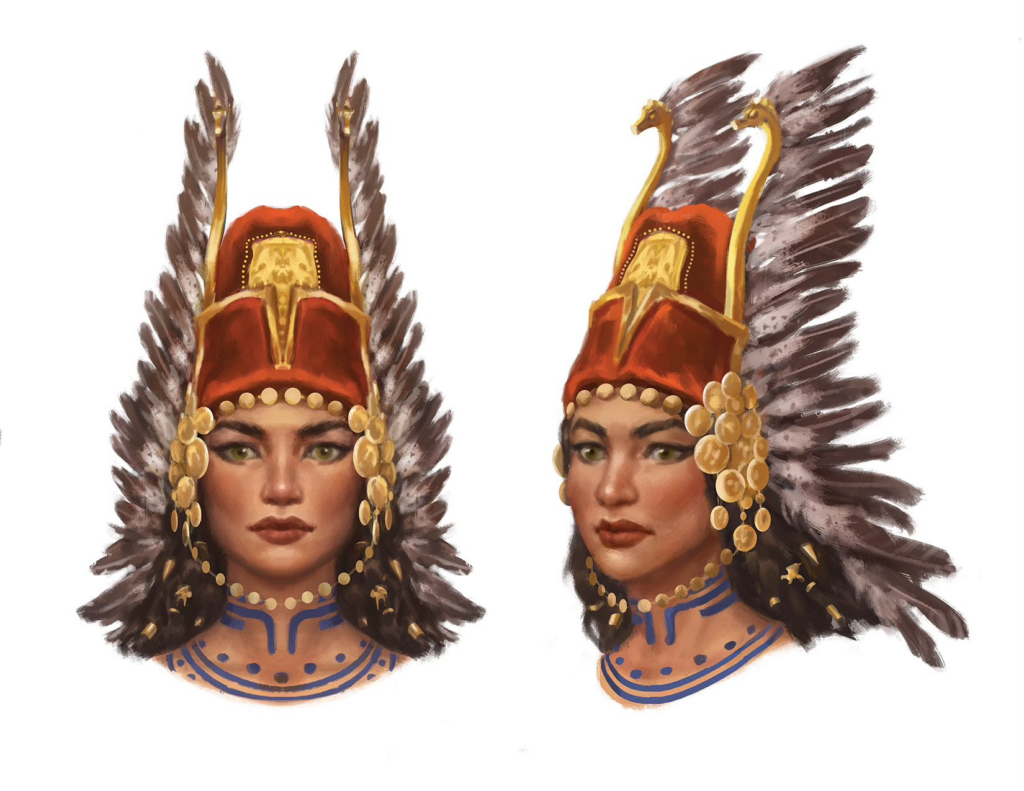There are a lot of horses in the Grazelands – some 90,000 – and it comes out to about 18 horses per square km. Now I thought that was very high, but actually it is a little more than three times the horse density of modern Maryland, and in line with horse numbers in much of the rural US before the automobile (horse numbers dropped nearly 90% between 1915 and 1960).
Family herds tend to be around 100 or so horses, around 3-4 nuclear families. That means there are nearly a thousand such herds wandering around the Grazelands. Each clan has about 7500 horses, but those horses are no doubt broken into many smaller and more manageable herds.
No wonder the Grazelanders so emphatically worship Ernalda – they need her agricultural productivity. I suspect part of the relationship with the farmers is that a big part of their land is dedicated to growing alfalfa, legumes, and oats for the horses! Probably about a third of the diet of the horses is oats grown by the farmers, and another big percentage is hay bailed up by the farmers. The horses also get to eat grass on the hills.
So you can imagine a thousand herds of horses wandering around the Grazelands, with their herders living in tents alongside them. The local farmers provide them with forage and concentrate, as demanded by the horse herders. The farmers also raise wheat and barley, vegetable, pigs, cattle, sheep, and other livestock, which provides bread, meat, cheese, etc. But I wouldn’t be surprised if a third to half the total harvest goes to the horses.
To the other Orlanthi, these farmers are abused – more than half their production goes to horses (and to their temples). They need to trade some fraction of what is left for craft goods and other necessities to the local trade post towns. But from the farmers’ perspective the horse herders largely leave them alone, and provide protection, and trade goods. Contrary to the opinion of outsiders, the vendref own their property and are not slaves. And if the horse herders get greedy, the farmers can always appeal to their beloved Feathered Horse Queen and her priestesses.
![]()
![]()
A couple of things –
- The Grazelanders are not true “nomads”. They are pastoralists, in that they move their herds around like sheep herders of Southern Europe move their sheep around. But the Grazelands are around 5000 sq km – that’s about the size of Delaware (and smaller than Larimer County here in Colorado). It is not going to support Central Asian style movements!
- Nomads are traditionally far more integrated into agricultural systems than people assume. There’s lots of great material on the relationship between the various Central Asian nomads and the settled agriculturalists.
- Adding grain to horses diet is the practice anywhere you have access to grain (and is the practice out here). As there are too many horses in the Grazelands to just live off the pasture in the hills, you need extra food.
The Grazers could not survive without their farmers. Some of the Yelmite leaders like to pretend that they could, but at the end of the day that was how the Feathered Horse Queen saved the Pure Horse People – by protecting and promoting the farmers, so that they could produce enough fodder for the horse herds.
In the Second Age, the Pure Horse Tribe is dominant in Prax, “integrated into the agricultural system” of the Oases, and the agriculturalists of the River of Cradles.
They get expelled into Dragon Pass – and for almost a century they have the run of the whole Pass, not just the modern Grazelands. But initially they don’t have an “agricultural system” as such: only Pure Horse Folk, Beast Men and Elder Races in the pass, and none of them are any good at farming. But the pony breeders range everywhere, which makes up for it.
Roll forward a century. More humans come to settle Dragon Pass, but the Yelmic Pure Horse People have lost the knack of working with a settled population. They oppress the farmers; they get pushed out of parts of their former range by Tarshites from the north and Quivini from the south-east; the FHQ rises up to oppose them; and we end up with synthesis: the modern mutual-support system of farmers supporting Grazer pastoralists.
The Pure Horse People need the farmers to survive. The farmers support and are supported by the Feathered Horse Queen, who is also the ruler of the Pure Horse People. She then allies with either Sartar or Tarsh to maintain her autonomy.
Now the Grazelanders are descended from those Pure Horse People who went to Prax in the Second Age. So they are a LONG way removed from their Pentan kin. In Prax, they overlapped with the Zebra Riders, and were closely linked to Pavis. Heck, the ruling dynasty of Golden Age Prax, the Arrowsmiths, came from them.
But this also means they have a lot of experience with the Lightbringers, Storm Bull, etc, even if there was a century long gap in that experience.

